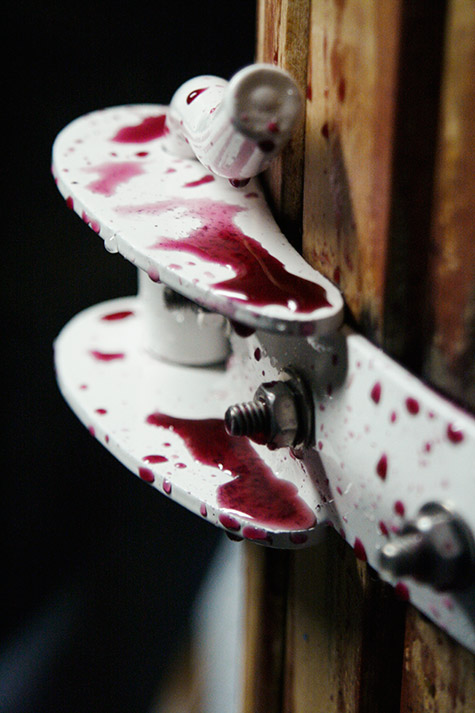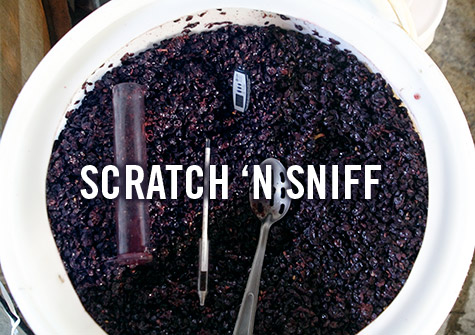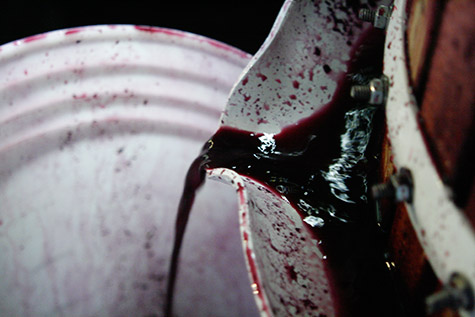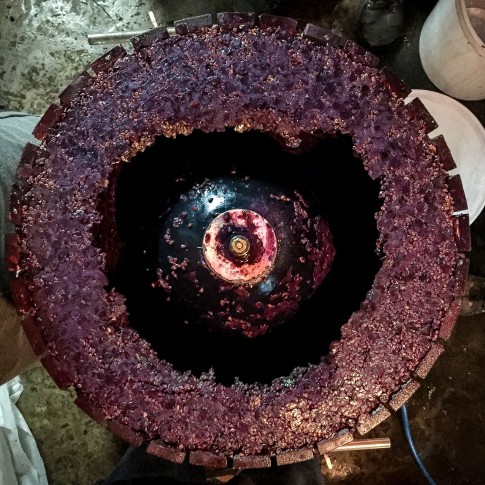Archive for the 'Fermentation' Category
Two down, five or so to go
As of last night around 10pm, Merlot and Viognier are bank yo.
The Merlot was amiable and lush, but surprisingly, not as overripe as I’d feared. We’re at about 26 brix (which is a measure of the sugar in the grapes), which in turn translates into about 15.5% alcohol. That’s a little rocket-fuel-y for genteel palates such as ours, so we’ll be adding some water, as well as acid, to bring this cuddly critter of a wine back into balance.
From the numbers and how it tasted, I think we ended up picking the Viognier at the perfect time. The sugar’s at 26 also (so as you might guess from the Merlot’s numbers, we’ll be watering back a bit), but the pH is at 3.45, which is phenomenal. So we’ve got a wine that, right off the vine, is already pretty balanced. Can’t wait to smell it fermenting… mmmmmm …
From the numbers I’ve seen from the vineyard, next up will either be the Cabernet Sauvignon or the Syrah, and very possibly in the next 5 days or so. So keep an eye on this space …
No commentsUpdate 2010: The Troubled Ones II
 Our Viognier may yet have a Hollywood ending. Our Rosé, well… by any other name, would taste as sweet…
Our Viognier may yet have a Hollywood ending. Our Rosé, well… by any other name, would taste as sweet…
Rosé
Our Rosé was a tank bleed (or “seignée”) of the Grenache right after it was crushed. I confess this one totally drank my lunch, tossing a number of problems at me I had no answers for. The biggest was thinking I was watching a nice, slow fermentation through the fall, then winter… then spring… when in fact primary fermentation had collapsed short of the goal and what I was actually seeing was malolactic fermentation (a secondary, bacteriological fermentation that changes malic acid into lactic acid). As a result, I didn’t realize this wine was “stuck” — not completely fermented and stalled in a sticky, quasi-alcoholic stasis — until a month or so ago.
Restarting a stuck ferment is notoriously hard, because you’re asking the yeast to start from a dead stop in an environment mostly toxic with alcohol (again, the ferment has nearly converted all the sugar to alcohol at this point, so the wine is pretty poisonous stuff as far as yeast is concerned). So I went through the laborious and time-consuming protocol recommended by the good folks at Scott Labs. It involves multiple nutrient additions over the course of a few days, then gradually adding waves of yeast over the course of an afternoon so they methodically gain confidence and territory without freaking out. In extreme cases, the protocol also calls for standing on one foot, baying at the moon, and whacking yourself with a switch.
Okay, those last three aren’t exactly in Scott Labs’ protocol, but I do think they helped in this case. One of the carboys actually finished, so now we need to decide if we should just blend the two together (the other is about 1% residual sugar), filter it, and call it a lesson learned; or figure out how to get the other one to finish.
Frankly, I’m ready to clear the decks, if only because the last thing I want to be doing in September as grapes arrive is pleading with a grumpy rosé. So I think we’ll probably just bottle it in the dark of some night and walk away, whistling innocently. It does still smell pretty decent behind all the yeast, so if we filter then blend the 1% and the nearly-none-percent carboys, we’ll have a wine that may be a tad sweet, but with luck, come off as “fruity” when chilled into restraint.
Here’s hoping…
No commentsStill fermenting!
Incredibly, the rosé still hasn’t finished fermenting — nearly 5 months after it started. The hint of CO2 in the head space does give the game away, but I’d assumed that was simply residual. So I checked the sugar: 1.75%, oceans away from dry. And it tastes it, too. Lovely nose, but too sweet in the mouth, like strawberry jam.
A long, cool fermentation is apparently just the thing for whites (and semi-whites like rosés), so I haven’t been too concerned. And the CO2 tells me the yeasts are still alive in there — it’s just been too cold to do much of anything, something with which I think we can all sympathize. But it’s time for these guys to get off the couch, shed the Snuggies, and finish the job. Unlike last year, I’d like to get this rosé sealed up early enough that it’s over bottle shock by the time the first warm Saturday afternoon rolls around.
So we’ll wrap the carboys in our electric mattress pad and apply just a hint of heat. I’m a little worried that malolactic fermentation will also jump-start (while malo’s just the thing for reds, it can muddy and over-soften whites), but que sera, sera. Malo seems to proceed much more slowly than primary fermentation, so with luck, the yeasts will race far ahead of the malo bugs and we can seal up a lovely rosé before things get too mellow.
No commentsThree down
 With the Pinot Noir now safely in carboys, the Franc ready to press tonight or tomorrow night, and the Cab nearly ready itself, Crush 2009 is starting to wind down. After the sound of rioting yeasts bubbling through wine all through the basement, the lower volume of finishing ferments is a little sad, like a sparsely populated dance floor at the end of a party.
With the Pinot Noir now safely in carboys, the Franc ready to press tonight or tomorrow night, and the Cab nearly ready itself, Crush 2009 is starting to wind down. After the sound of rioting yeasts bubbling through wine all through the basement, the lower volume of finishing ferments is a little sad, like a sparsely populated dance floor at the end of a party.
But the light fantastic isn’t fully tripped yet. As I mentioned, the Franc is now weakly mustering a cap, a sign (along with hydrometer readings) it’s pretty much done and ready for the press. It smells terrific, like cran-raspberry flowers, if such a thing exists. We’ll probably press it tonight, from the looks of the sign-up sheet we’ve been using via Doodle.
Next is the Cabernet Sauvignon. It’s close to done itself, but I want to experiment with a short “extended maceration” on this big-shouldered wine, pulling more flavor and more tannin into it. Some wineries leave their wines to soak for more than a month after fermentation is finished, which contrary to what you’d think supposedly coaxes round, soft tannins from the skins. That requires better equipment that we have, since you really need to seal off the wine against the ravages of oxygen, now that the yeast is no longer producing a blanket of CO2 to protect the surface. But we’ll seal it as best we can and keep an eagle eye on it, pressing before anything heads precipitously south.
No commentsI’m blown away

That’s right, go ahead. No one’s looking: scratch the screen. Doesn’t that Pinot Noir smell incredible? Good god!
For those of you with older monitors, let me try to describe what it smells like. First, I should say I’ve made Pinot Noir before, and I’ve loved the wine for years. I was even on the Board of the International Pinot Noir Celebration for a while. So I understand why people like it, and I’ve smelled my share of it, during and well after fermentation.
But I don’t think I really understood how it can become an addiction, something winemakers throw their entire lives into, until this began to overwhelm my senses. Holy shit: this is ambrosial.
Some of it is surely how much is packed into this fragrance: ripe cherries, but not just cherries; their delicate stems, the branches holding them, a light breeze gently riffling them on a warm fall afternoon, coaxing out the fragrance of the entire orchard you kick up a little earth walking beneath. There’s tea, maybe a pekoe; and roses, a mixed garden of them, and along with a nearby raspberry bramble, warmed by the sun and transported on the air. And there’s something darker, richer, more earthy, maybe some tobacco, and a whiff of lavender bees are happily hovering through.
But what really takes it past a mere perfume counter it is the balance of all these fragrances, which play in and out of one another like the honey bees I just mentioned, their gentle buzzing, like the CO2 wafting above the cap, adding yet another sensory layer and sharpening the whole experience just so.
Incredible. Think there’s any way we can bottle this? Oh… right!
No commentsOne down, six to go
 Last night we pressed the Syrah, sending it barreling toward French oak and malolactic fermentation. It was the first red to finish this year, and the first real test of our reconditioned wine press, so we weren’t totally sure what would come out the other end.
Last night we pressed the Syrah, sending it barreling toward French oak and malolactic fermentation. It was the first red to finish this year, and the first real test of our reconditioned wine press, so we weren’t totally sure what would come out the other end.
Luckily, what emerged was an inky purple blacksmith of a wine, burly but agile, if not kryptonite for any white garments or pearly teeth nearby. As we loaded it into the press, it filled the basement with an enthralling animal, dark-berry fragrance, and as it cascaded off the trough into the bucket, it tasted full and juicy through the mid and beyond. Wow.
(All images for this post courtesy of our guest photographer, Layla Grice) Read more
1 comment
